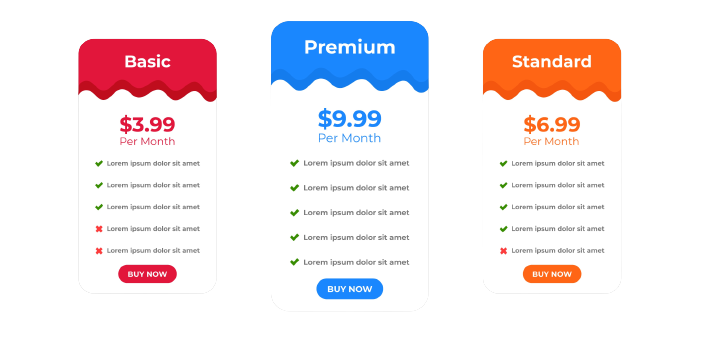
In this digital era, subscription services models have revolutionized the way we access products and services, shaping our everyday lives in ways we may not even realize. Behind the seamless user experience and recurring charges lies a fascinating realm of consumer behavior and decision-making intricacies that propel these models to unprecedented heights of success.
Have you ever wondered why you eagerly await that monthly package on your doorstep? Or why do you find it challenging to resist signing up for yet another streaming service, even when you have countless hours of content already at your fingertips? The answers can be found in the fascinating interplay between how our minds work and the clever strategies used by businesses in the world of subscriptions services.
In this blog, we will explore the reasons why we are drawn to subscription offerings and uncover the psychological factors behind our enthusiasm for them. From the subconscious biases that shape our preferences to the clever tactics used by companies to ignite our desire for more, we delve deep into the secrets behind the success of these ever-expanding business models. Additionally, we will discuss how a CRM for small business can further enhance the effectiveness of subscription-based businesses, providing valuable insights and tools to manage customer interactions and drive growth.
We will uncover how subscription services tap into fundamental psychological principles, leveraging cognitive ease and behavioral patterns to simplify our choices and keep us coming back for more. Additionally, we will explore the role of emotions in subscription decision-making, as businesses deftly utilize the fear of missing out (FOMO) and the joy of surprise to build lasting connections with their subscribers. CRM for small business plays an important role in this.
Whether you are a curious consumer seeking to understand your own behavior or an astute entrepreneur looking to leverage these insights for business growth, this blog will equip you with valuable knowledge to navigate the intricate world of subscriptions. As we journey through the hidden corners of the human mind and unravel the mysteries of consumer decision-making, you’ll gain a fresh appreciation for the ingenious strategies that underlie some of the most successful subscription services of our time.
let’s explore the hidden secrets behind the psychology of subscriptions, where the science of human behavior merges with smart business strategies, offering endless possibilities for both consumers and entrepreneurs.
Why Do Consumers Love Subscription Services?

Consumers love CRM for small businesses with subscription features for a multitude of reasons, each catering to their desire for convenience, personalization, and enhanced experiences. As the digital landscape continues to evolve, these subscription models have taken center stage, transforming how we access products and services in almost every aspect of our lives. Let’s delve into the key factors that make subscription services so appealing to consumers:
- Convenience at Your Fingertips: One of the primary reasons consumers are drawn to subscription services is the unparalleled convenience they offer. With just a few clicks, users can sign up for a service and gain access to a vast array of products or content, all delivered right to their doorstep or accessible through their devices. The hassle of repeated visits to physical stores or the need to individually purchase items becomes a thing of the past, allowing subscribers to focus on what truly matters to them.
- Personalization and Tailored Experiences: Personalization is the cornerstone of many successful subscription services. Companies analyze consumer data and preferences, providing personalized recommendations that match individual tastes and needs. Whether it’s curated product boxes based on specific interests or tailored content playlists, this level of customization fosters a sense of connection between consumers and the brand, making them feel seen and understood.
- Cost-Effectiveness and Value Proposition: While CRM for small business with subscription services often involve recurring payments, many consumers find them cost-effective in the long run. By bundling products or services together, companies can offer a more attractive package at a lower price compared to purchasing each item separately. This value proposition is enticing, especially when subscribers believe they are getting more than what they pay for.
- Fear of Missing Out (FOMO) and Exclusive Offers: Human psychology plays a significant role in why consumers are attracted to subscription services. Fear of Missing Out (FOMO) is a powerful emotion that companies leverage to great effect. Limited-time offers, exclusive access to content, or members-only perks create a sense of urgency and exclusivity, enticing consumers to subscribe to avoid feeling left out.
- Simplified Decision-Making and Reduced Commitment: The abundance of choices in today’s marketplace can often overwhelm consumers, leading to decision fatigue. Subscription services alleviate this burden by streamlining choices. Once a consumer subscribes to a service, they no longer need to repeatedly decide whether to purchase a product or service individually, reducing decision-making stress. Additionally, CRM for small business with subscription plans usually offer flexible terms, allowing users to easily modify or cancel their subscriptions, providing a sense of freedom and reduced commitment.
- Element of Surprise and Delight: Many subscription models include an element of surprise, such as mystery boxes or personalized surprises in each delivery. This element of anticipation and delight enhances the overall experience and keeps subscribers excited about each delivery.
- Continuous Access to Updates and New Features: In the realm of software and digital services, subscriptions often grant consumers continuous access to updates and new features. This ongoing improvement and innovation ensure that subscribers stay up-to-date with the latest advancements, enhancing their overall user experience.
By tapping into psychological drivers, subscription businesses create lasting connections with their customers, fostering loyalty and long-term relationships.
How Do Psychological Biases Affect Subscription Choices?

In the world of subscription choices, our decisions are far from purely rational. Instead, they are significantly influenced by a myriad of psychological biases that silently shape our preferences and behaviors. These subconscious mental shortcuts often lead us to make choices that may not align with our best interests but are nonetheless powerful drivers behind the growth and success of subscription models.
Let’s explore some key psychological biases that affect our subscription choices:
1. Anchoring Bias: The anchoring bias occurs when we rely too heavily on the first piece of information we receive when making a decision. In the context of subscriptions, this could manifest in our tendency to be strongly influenced by initial pricing offers or introductory deals. For instance, when presented with a lower-priced entry-level subscription package using CRM for small business, we may perceive it as a bargain, even if the subsequent subscription levels are comparatively expensive. Businesses can leverage this bias by strategically offering attractive initial pricing to anchor customers to their brand.
2. Availability Heuristic: The availability heuristic refers to our tendency to base our decisions on readily available information, rather than conducting a comprehensive evaluation of all options. In the subscription world, this might mean that we opt for the services that are most heavily advertised or that we hear about frequently from friends or influencers. Marketers can exploit this bias by ensuring that their subscription services are visible and accessible through various channels to increase their perceived availability.
3. Status Quo Bias: As creatures of habit, we often prefer to stick with what is familiar and resist change. The status quo bias can lead us to maintain existing subscriptions, even when better alternatives exist. Canceling a subscription may require effort, time, or discomfort, and this bias can prevent us from exploring new options. Companies can capitalize on this bias by making it effortless for customers to continue their subscriptions and providing incentives for loyalty.
4. Loss Aversion: Loss aversion refers to our tendency to strongly prefer avoiding losses over acquiring gains of equal value. In the subscription context, this bias can influence our decision-making when considering canceling a subscription. The fear of losing access to products or services, along with the associated benefits, may make us reluctant to terminate a subscription, even if we no longer find it valuable. Subscription providers can utilize this bias to retain customers by emphasizing the potential losses they would face if they unsubscribe.
5. Default Bias: The default bias occurs when we are more likely to choose an option that is pre-selected or set as the default choice. In subscription sign-ups, this bias can be leveraged by automatically opting users into certain subscription features or renewals. Many customers may simply accept the default settings without actively considering alternatives. Businesses can use this bias to their advantage by offering opt-out subscription models, ensuring continued revenue from customers who may not actively reassess their subscription preferences.
Understanding these psychological biases empowers both consumers and businesses to make more informed decisions in the world of subscriptions using CRM for small business. As consumers, recognizing these biases can help us become more mindful of our choices and avoid falling into traps that may lead to unnecessary expenses.
Power of FOMO: Revolutionizing Fear of Missing Out in Subscription Marketing

FOMO, or the “Fear of Missing Out,” is a powerful psychological phenomenon that taps into our natural desire to be included and part of something special. It arises when we see others enjoying experiences or benefits that we are not currently a part of, leading to a sense of anxiety or apprehension about being left out. This fear is amplified in today’s hyper-connected world, where social media platforms constantly showcase the exciting and envy-inducing activities of friends, family, and influencers.
Savvy businesses use FOMO to their advantage. They create a sense of urgency and exclusivity around their subscription offerings to trigger the fear of missing out on valuable content, products, or services. Here’s how they do it:
- Limited-Time Offers
- Exclusive Content and Benefits
- Social Proof and Influencers
- Limited Availability
By skillfully implementing these FOMO-driven strategies using CRM for small business, businesses create a strong motivation for consumers to subscribe and remain engaged with their service. This fear of missing out not only helps attract new subscribers but also fosters a sense of loyalty, as people want to continue receiving the perceived benefits and staying part of the community.
However, it’s essential for businesses to strike a balance and maintain genuine value in their offerings. While FOMO can be a powerful tool, overusing it or relying solely on gimmicks without substance can lead to disillusioned customers and ultimately harm the brand’s reputation.
Thus, it can be said that the power of FOMO in subscription marketing lies in its ability to tap into our innate desire for inclusion and create a sense of urgency around subscription services. By taking benefit of this psychological trigger strategically and responsibly, businesses can effectively attract, retain, and engage subscribers, while customers feel they are part of an exclusive and valuable experience.
Unlocking the Subscription Mindset: How Habits Drive Consumer Behavior

In SAAS or Subscription-based businesses, there’s more to consumer behavior than meets the eye. Behind the seemingly effortless decisions to sign up for monthly boxes, streaming services, or software subscriptions lies the power of habits. Human beings are creatures of habit, and these routines play a crucial role in driving our choices, particularly when it comes to subscribing to products and services. Using CRM for small businesses may definitely help you create great subscription options for your users.
Understanding Habits and Their Formation:
Habits are automatic behavioral patterns that develop through repetition and reinforcement. When we perform an action repeatedly in response to a specific cue or trigger, our brains create neural pathways that make the behavior more automatic and less reliant on conscious decision-making. In the context of subscriptions, the repeated experience of receiving value-packed deliveries or accessing content on a regular basis strengthens these neural connections, making the act of subscribing feel almost second nature.
The Habit Loop and Subscription Decisions:
Charles Duhigg, in his book “The Power of Habit,” explains the habit loop, which consists of three key elements: cue, routine, and reward. This loop sheds light on how habits shape consumer behavior in the subscription landscape.
1. Cue: The cue is the trigger that initiates the habit. It could be an external stimulus, an internal emotional state, or even a specific time of day. For example, receiving an email notification about a limited-time offer for an exclusive subscription box can serve as a powerful cue.
2. Routine: The routine is the behavior itself—the action that follows the cue. Subscribing to the service or purchasing the product becomes the routine, especially when it aligns with the cue. This action provides a sense of fulfillment or satisfaction.
3. Reward: The reward is the positive outcome or feeling that results from completing the routine. In the case of subscriptions, the reward might be the anticipation of exciting packages arriving regularly, gaining access to premium content, or enjoying the convenience of automated services.
As consumers experience this habit loop repeatedly, the behavior becomes ingrained, solidifying the subscription mindset.
The Role of Positive Reinforcement:

Positive reinforcement is a critical factor in habit formation and maintenance. Subscription businesses often use various techniques to reinforce the habit loop and create positive associations with their services. Some common strategies include:
- Personalization: Tailoring subscription offerings to individual preferences enhances the feeling of exclusivity and personal connection, making subscribers more likely to continue their routines.
- Surprise and Delight: Introducing elements of surprise, such as limited-edition items or unexpected bonuses, creates positive emotions that further reinforce the habit.
- Convenience and Accessibility: Easy-to-use platforms and seamless experiences remove barriers, encouraging consumers to continue their subscription routines without friction.
Breaking Habits and Churn Management:
Just as habits can drive consumers to subscribe, they can also lead to churn if not managed effectively. Churn refers to the rate at which subscribers cancel their memberships. To reduce churn, businesses must be attentive to potential negative cues, routines, or rewards that might undermine the subscription mindset.
By understanding the power of habits and their influence on consumer behavior, subscription businesses can craft strategies that resonate with their target audience, foster long-lasting relationships, and ensure continued success in a competitive market.
The subscription mindset is rooted in the formation and reinforcement of habits. As consumers repeatedly experience the habit loop, triggered by cues and driven by rewards, subscribing to products and services becomes an integral part of their daily lives. Businesses that grasp the significance of habits can create compelling subscription experiences, build a loyal customer base, and secure a prominent position in the dynamic world of subscriptions.